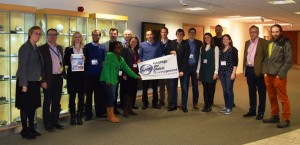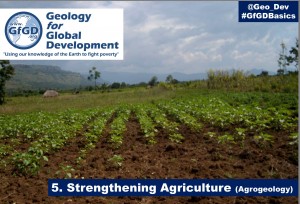 In January 2015, GfGD took a small group of members to a discussion event hosted by the British Geological Survey, on best practice in international development. Ben Clarke and Eleri Simpson, then final year undergraduates at the University of Leicester (UK) joined the event to share about their fantastic work in Vanuatu. Here they write a guest blog about one presentation that caught their interest…
In January 2015, GfGD took a small group of members to a discussion event hosted by the British Geological Survey, on best practice in international development. Ben Clarke and Eleri Simpson, then final year undergraduates at the University of Leicester (UK) joined the event to share about their fantastic work in Vanuatu. Here they write a guest blog about one presentation that caught their interest…
Mélanges, magmas and micrites are all familiar terms in geology, but what have micronutrients got do with anything? Quite a lot it appears. This is one of the least known aspects of study that the British Geological Survey (BGS) undertakes, and formed one of many fascinating discussions held between BGS and GfGD on a rainy day in January.
Micronutrients are the substances we all need, in small amounts, to develop properly; from Vitamin A to Zinc they decide whether we develop and maintain an immune system, a fully functioning brain and even whether we can see or not. It seems imperative therefore, that we get enough of them. This isn’t the always the case, in fact it’s estimated that in excess of two billion people on Earth don’t receive enough 1. What’s more is the effect can be measured economically: economic loss associated with micronutrient deficiency (or hidden hunger) is thought to amount to 2.5% of India’s Gross Domestic Product (GDP) 2; to bring this into perspective this amounts to about £15 billion in 2007. But why? If children don’t receive enough Iron or Iodine, their cognitive development is impaired, they don’t achieve academically at school and they don’t become the scientists, doctors and business-people that the country needs to flourish. If adults don’t get enough Iron or Vitamin A, they become tired and are ill more regularly, straining any medical system that may exist and reducing productivity. It seems not just because of the day-to-day effects of such ‘hidden hunger’ on humans, but also the economic effects on entire countries to be in everyone’s interest to tackle the problem.
 So where do we get these substances from? This is where geology comes in. We receive micronutrients from the foods we eat, but the concentration of them in food depends on the soil it’s grown in. If you want to understand the soil, speak to a soil scientist. Dr Michael Watts, a geochemist at the BGS works in partnership with scientists from universities in Malawi, Zambia and Zimbabwe to study the problem and to find simple solutions that can be easily implemented on a local level. Methods such as using enriched fertilizers and planting crops that more readily absorb micronutrients in the soil have the potential to vastly change lives on a local level, and if scaled up may produce enormous regional impacts. But for such schemes to be sustainable, it requires local initiative, and because of this the BGS aims to fund doctoral training programmes and PhD exchange schemes for African students so that in time these countries have the expertise to tackle the problems themselves.
So where do we get these substances from? This is where geology comes in. We receive micronutrients from the foods we eat, but the concentration of them in food depends on the soil it’s grown in. If you want to understand the soil, speak to a soil scientist. Dr Michael Watts, a geochemist at the BGS works in partnership with scientists from universities in Malawi, Zambia and Zimbabwe to study the problem and to find simple solutions that can be easily implemented on a local level. Methods such as using enriched fertilizers and planting crops that more readily absorb micronutrients in the soil have the potential to vastly change lives on a local level, and if scaled up may produce enormous regional impacts. But for such schemes to be sustainable, it requires local initiative, and because of this the BGS aims to fund doctoral training programmes and PhD exchange schemes for African students so that in time these countries have the expertise to tackle the problems themselves.
It’s great to see that research like this is being so thoughtfully and effectively undertaken by the BGS but we can’t sit on our laurels, micronutrient deficiency isn’t just a problem in Africa: Bangladesh, Honduras, India and many other countries also suffer. Far more work is still required by the next generation of geologists, biologists, chemists and anthropologists to enrich our diets. It’s surprising what you might learn on a rainy day in January.
1 Kennedy, G., Nantel, G., Shetty, P. 2003. The scourge of “hidden hunger”: global dimensions of micronutrient deficiencies. Food, Nutrition and Agriculture (FAO). 1014-806X, (no.32) p. 8-16.
2 Stein, A., Qaim, M. 2007. The human and economic cost of hidden hunger. Food and Nutrition Bulletin, vol. 28, no. 2, p. 125-134
Dr Michael Watts will be joining the 3rd GfGD Annual Conference (Friday 30th October 2015, The Geological Society, Burlington House, London). He will be joining a panel discussion on geology and the Sustainable Development Goals. Information and registration details here.
—
Editors Note (3:10pm, 4th Sept 2015): There is an excellent blog on the BGS website also discussing this theme.
